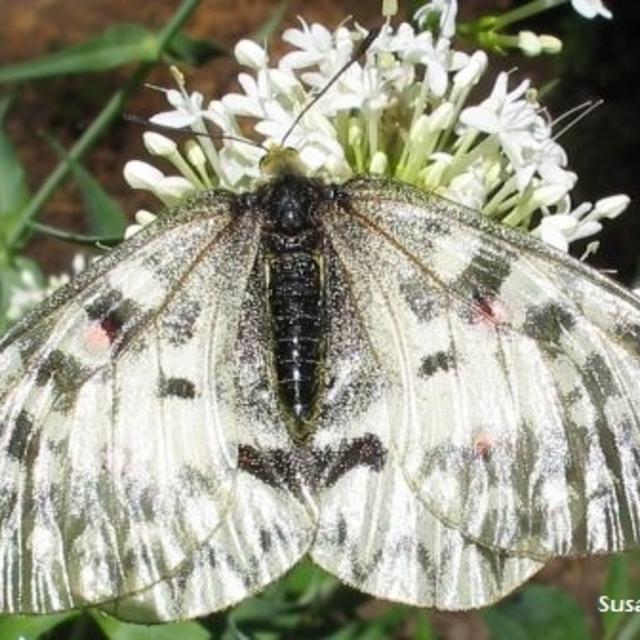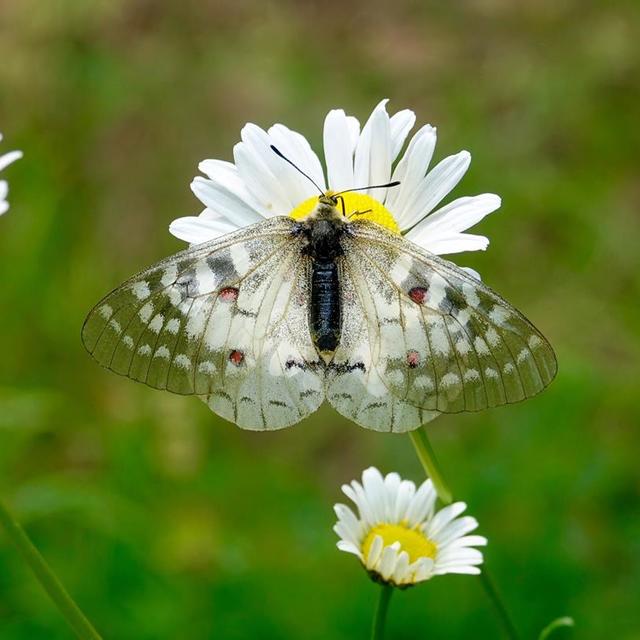Clodius Parnassian
Parnassius clodius Ménétriés, 1857
Family: Papilionidae
Subfamily: Parnassiinae
Identification: Upper surface of forewing cell with 3 dark gray bars. Front wing has no red spots. Upper surface of hindwing with 2 red spots; female usually has red anal bar. Mated females have large, white keeled pouch (sphragis) at end of abdomen.
Wing Span: 2 - 2 1/2 inches (50 - 62 mm).
Life History: Males patrol habitat to find females; after mating they attach a pouch to female to prevent multiple matings. Females lay single eggs scattered on the host plant. Caterpillars feed at night at the base of host plant and pupate in a loose silk cocoon above ground. Overwintering is by the egg stage.
Flight: One flight in June - July.
Caterpillar Hosts: Bleeding heart family (Fumariaceae) including Dicentra uniflora, D. formosa, and D. pauciflora.
Adult Food: Flower nectar.
Habitat: Open woods, alpine areas, meadows and rock outcrops.
Range: Western Canada and western United States.
Conservation: Subspecies strohbeeni from California's Santa Cruz Mountains is extinct.
NCGR: G5 - Demonstrably secure globally, though it may be quite rare in parts of its range, especially at the periphery.
Management Needs: None noted.
Comments: NULL
BAMONA Shop
Please donate!
We depend on donations to keep Butterflies and Moths of North America freely available. We want to express our gratitude to all who showed their support by making a contribution this year. You can donate to support this project at any time.
Advertise with us!
Do you have a product or service that you think would interest BAMONA users? If you would like to advertise on this website, contact us by email, or use the contact form and select the "Advertising" category.
Verified Sightings
Displaying 1 - 24 of 500 verified sightings

Observation date: Jul 22, 2025
Submitted by: sandyleapt
Region: Benton County, Oregon, United States
Verified by: Ken Davenport
Verified date: Aug 18, 2025

Observation date: Jul 22, 2025
Submitted by: regina rochefort
Region: Skagit County, Washington, United States
Verified by: davidwdroppers
Verified date: Jul 30, 2025

Observation date: Jul 08, 2025
Submitted by: Zach Eckert
Region: Thurston County, Washington, United States
Verified by: davidwdroppers
Verified date: Jul 25, 2025

Observation date: Jul 19, 2025
Submitted by: Debbiejo
Region: King County, Washington, United States
Verified by: davidwdroppers
Verified date: Jul 25, 2025

Observation date: Jul 12, 2025
Submitted by: Reneerob17
Region: British Columbia, Canada
Verified by: Paul Prappas
Verified date: Jul 20, 2025

Observation date: Jul 05, 2025
Submitted by: Funkki
Region: Lane County, Oregon, United States
Verified by: Ken Davenport
Verified date: Jul 08, 2025

Observation date: Jun 11, 1983
Submitted by: papilio1
Region: Tehama County, California, United States
Verified by: Ken Davenport
Verified date: Jul 07, 2025

Observation date: Sep 06, 2011
Submitted by: papilio1
Region: Alpine County, California, United States
Verified by: Ken Davenport
Verified date: Jul 06, 2025

Observation date: Jul 26, 1990
Submitted by: papilio1
Region: Mono County, California, United States
Verified by: Ken Davenport
Verified date: Jul 06, 2025

Observation date: Jun 26, 2025
Submitted by: PDunwiddie
Region: Cowlitz County, Washington, United States
Verified by: davidwdroppers
Verified date: Jul 06, 2025

Observation date: Jun 29, 2025
Submitted by: pgericks
Region: Snohomish County, Washington, United States
Verified by: davidwdroppers
Verified date: Jul 05, 2025

Observation date: Jun 05, 2025
Submitted by: nirvanh
Region: Clallam County, Washington, United States
Verified by: davidwdroppers
Verified date: Jun 08, 2025

Observation date: Jul 17, 2024
Submitted by: Nancy Gleason
Region: Jefferson County, Washington, United States
Verified by: davidwdroppers
Verified date: Mar 18, 2025

Observation date: Sep 07, 2024
Submitted by: weflybye
Region: Mason County, Washington, United States
Verified by: davidwdroppers
Verified date: Sep 08, 2024

Observation date: Aug 31, 2024
Submitted by: weflybye
Region: Grays Harbor County, Washington, United States
Verified by: davidwdroppers
Verified date: Sep 03, 2024

Observation date: Aug 29, 2024
Submitted by: weflybye
Region: Clallam County, Washington, United States
Verified by: davidwdroppers
Verified date: Sep 02, 2024

Observation date: Aug 29, 2024
Submitted by: Chris Carvalho
Region: Skamania County, Washington, United States
Verified by: davidwdroppers
Verified date: Sep 02, 2024

Observation date: Jul 31, 2024
Submitted by: sandyleapt
Region: Benton County, Oregon, United States
Verified by: Ken Davenport
Verified date: Aug 16, 2024

Observation date: Jul 31, 2024
Submitted by: sandyleapt
Region: Benton County, Oregon, United States
Verified by: Ken Davenport
Verified date: Aug 16, 2024

Observation date: Aug 16, 2024
Submitted by: weflybye
Region: Clallam County, Washington, United States
Verified by: davidwdroppers
Verified date: Aug 16, 2024

Observation date: Jul 19, 2024
Submitted by: Robert Gorman
Region: Rich County, Utah, United States
Verified by: James Steen
Verified date: Aug 11, 2024

Observation date: Jun 11, 2022
Submitted by: Alison Davies
Region: Fresno County, California, United States
Verified by: Ken Davenport
Verified date: Aug 09, 2024

Observation date: Jul 14, 2024
Submitted by: Buddy Mays
Region: Jefferson County, Oregon, United States
Verified by: Ken Davenport
Verified date: Aug 08, 2024

Observation date: Aug 07, 2024
Submitted by: weflybye
Region: Mason County, Washington, United States
Verified by: davidwdroppers
Verified date: Aug 07, 2024
- 1 of 21
- next ›







